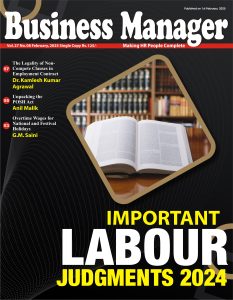There is a limit to what can be achieved through statutes, regulations, legislations, directives and more. Ultimately, practices determine, substantially, the directions that organizations take.
Practices are often unwritten. Good sense determines their validity.
Unfortunately, good sense cannot be given, taught or ordered by directives. It is something which emerges by the paths that are cut by people’s behavior and thoughts. In course of time, they acquire a determining role and are at times known even to supersede the drafted regulations themselves.
How this happens is not difficult to understand because, ultimately, all rules and regulations are just as valid as the players and hierarchy of the institution allow it to do so. After all, legislation does help to provide the pillars of the organization but it does not always substitute for alive and orderly flow of events and practice of legislation. This fundamental postulate applies usually to the early years of in-house learning institutions and gets a vibrancy of their own. Once these practices get institutionalized, it is difficult to negate them or even ignore them.
Learning institutions have their own unwritten script of practices but so have all others too. The un-written practices can flow from various sources including statutes, memorandum of institutions, the will of the Board the power and range of CEO and more. To decipher it need observation, documentations sometimes projecting the future to check its veracity.
All in all it keeps determining its own identity a leaving its imprint on decision making.
Be that as it may, many people in authority do not quite see and, even to a lesser extent visualize how to create a vibrant pro-active culture. For that to happen, any institution in its early years requires a live set of individuals to proactively monitor the working method of the institution and contribute to it with wisdom and foresight.
Unless this happens, the vibrancy of the earlier years of a any institution may be quite reduced. It is not only that the learning and training institution which can begin with a false step, so can other institutions. The long and short of it is that the baggage of these traditions continues long. It is at timescorrosive even, to attempt to moderate the way wardness of the key individuals at certain stages of institutions growth. Never-the-less the task cannot be abandoned. Indeed the requirements are of keeping a firm observational map of the same.
In terms of institution building, the collective leadership of its programs, and processes needed, they need not necessarily be rigidly structured. Subsequent experiences may need new spaces for growth and experiment.
Thus, it is that like any stage of the organization, in the earlier stages, the type of leadership one has in a given organization is nearly as important as any other dimension of organizational functioning. Unfortunately, all traits of leadership are difficult to assess either from the bio-data or presentations or the track record of any individual’s bio-data. Thus, it is that all leadership positions in action need to have spaces for experimenting, assessing. Once the results are positive then only can one be given a full tenure of control. This experience varies from one type of institution to another.
Bureaucracies are a given type of institution, as indeed are commercial institutions or consultancy institutions or learning institutions and indeed the list can go on. Hence, it is a possible conclusion that, unless there is contrary evidence of a substantivevariety, the leadership process at the top should graduate through various levels of enunciation. They could be group leadership, dual leadership, or individual leadership, with the mentoring role of ‘seniors’ thrown in for the much needed reference.
A study of success story of effective institutions shows that this indeed is the rollout process. There is clearly a need for serious reflection and consideration of steps of institution building and the gradual institutionalization of review, and reform of the on-going.
One possible way of doing so could be through the Board of Directors and Governors playing an active design role in the running of the institution. That is a subject matter which could well be handled by careful research and due diligence.
























